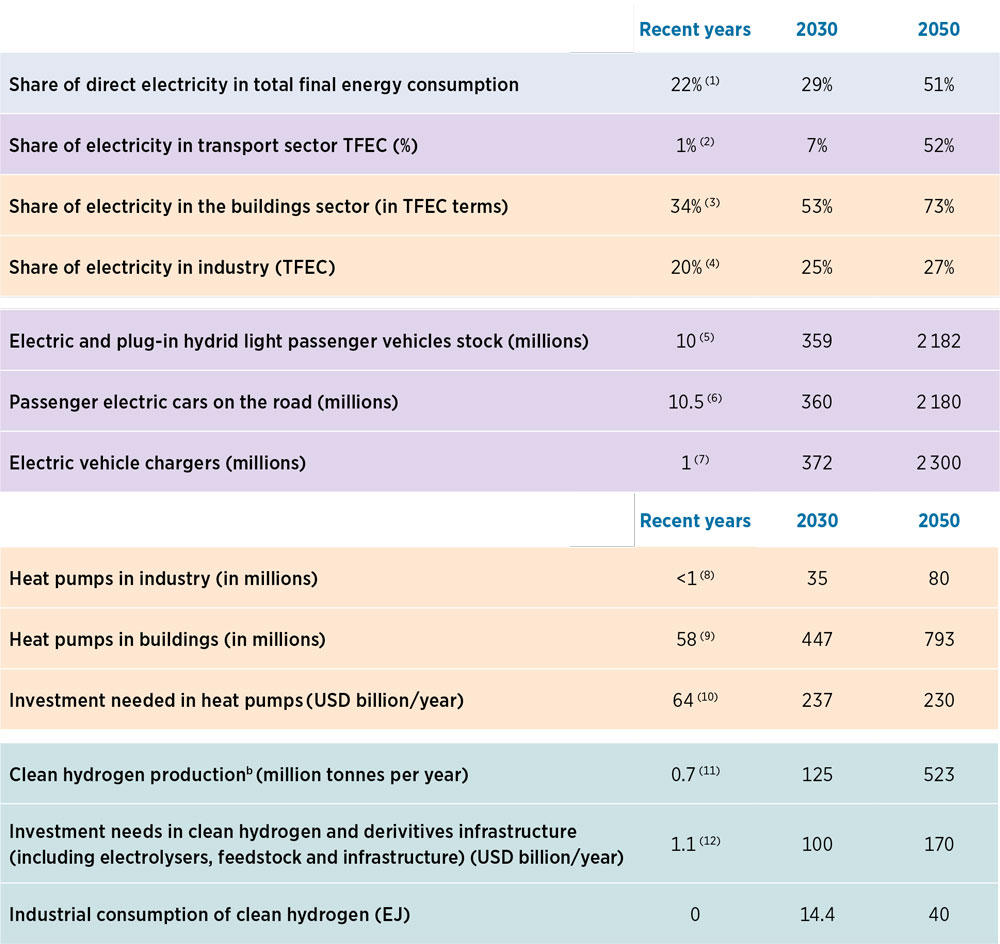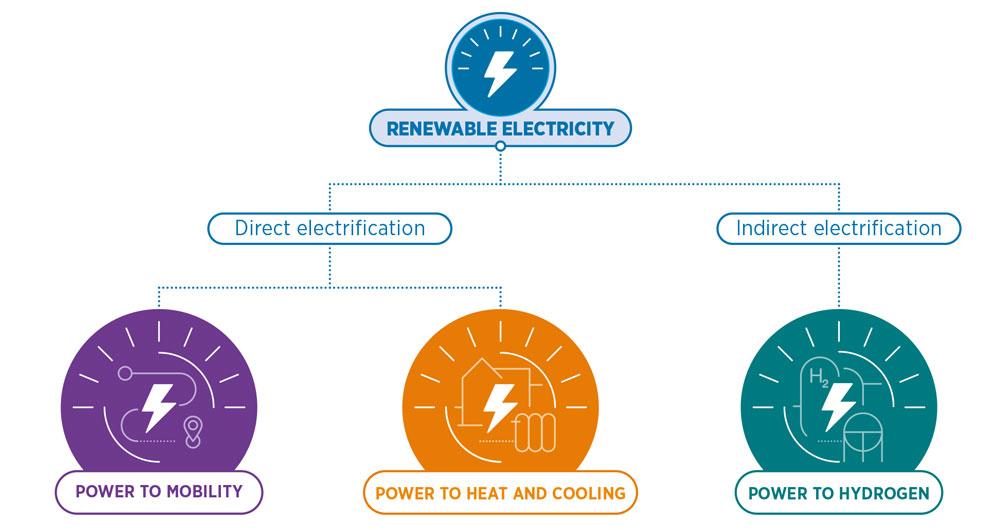Systemic innovation is needed to achieve smart electrification of end-use sectors
The world has already begun a historic shift towards cleaner sources of energy. Rapid reductions in the cost of solar and wind technologies have led to widespread adoption of these technologies, which are now dominating the global market for new power generation capacity.
But the pace of change must accelerate if we are to meet sustainability and climate goals. We need an even faster expansion of renewables, along with a smarter, much more flexible electricity grid. Equally important is the need for significant increases in the range of products and processes that run on clean electricity in major end-use sectors, notably industry, buildings and transport.
Because the electrification of end uses enables the use of efficient technologies, widespread electrification – combined with efficiency measures – will decrease total global energy consumption. In IRENA’s analysis, meeting the goals of the 2015 Paris Agreement on Climate Change will require the share of electricity in the energy mix to rise from 22% in 2020 to 51% in 2050, as shown in Figure I.1.
FIGURE I.1 Final energy mix in 2018 and 2050

But the electrification of end uses alone is not enough. Electrification must be done in a “smart” way, both by interconnecting the power sector with other energy sectors, such as heat and mobility, and by enabling flexible sources across all energy sectors. Electric vehicles, for example, not only cut greenhouse gas emissions dramatically, they can also feed electricity to the grid, reducing the need to build additional generation capacity. Smart electrification, through sector coupling, flexibility and energy efficiency, thus prevents a higher electricity load for the power system and is a tremendously powerful tool for decarbonising the energy sector, including end uses.
Smart electrification enables the power system to accommodate new loads in a cost-efficient manner. It also builds flexibility into the power system, thereby permitting the integration of a higher share of renewables and making the power system more robust and resilient. Smart electrification is the most cost-effective solution for decarbonising major end uses such as transport and heating.
Moreover, smart electrification with renewables creates a virtuous cycle. Electrification drives new uses and markets for renewables. That, in turn, accelerates the switch to electricity for end uses, creating even more flexibility and driving further growth in the use of renewables and continued technological innovation. Growth and innovation also cut costs and create additional opportunities for investment and business.
Innovation is the foundation for smart electrification and the global energy transformation. Most innovations cannot be implemented in isolation, nor are they limited to technology-based solutions. Along with innovation in technology and infrastructure, innovations are also needed in market design and regulation, system planning and operation, and business models. Innovative solutions will consequently emerge from the complementarities of advances across multiple components of energy systems and leveraging the synergies of these innovations in a process called systemic innovation.
The 100 key innovations identified in this report are spread across four dimensions: (1) technology and infrastructure, (2) market design and regulation, (3) system planning and operation, and (4) business models (Figure I.2). It is only by matching and leveraging synergies in innovations in all parts of the power system and end-use sectors and including all relevant actors and stakeholders that successful solutions can be implemented on the ground.
FIGURE I.2 Dimensions of systemic innovation

Smart electrification cannot be pre-packaged. Optimal strategies for power system design and the application of innovation will vary among countries and their specific attributes, including both the technical and economic aspects of a given power system and its social and cultural context.
Electricity will be the main energy carrier in future energy systems
Achieving the Paris Agreement goal of limiting the increase in the global average temperature to 1.5°C relative to pre-industrial levels is the unifying principle behind IRENA’s 1.5°C Scenario. To achieve that scenario, the share of electricity in total final energy consumption (TFEC) will have to grow from 21% in 2019 to 29% by 2030, and to 51% by 2050; this can be achieved through tremendous growth in technologies that operate on electricity, many of which are already available (IRENA, 2023). These include electric vehicles (EVs) and heat pumps, which provide heat for buildings and many industrial processes. In addition, end uses that are difficult to electrify directly, such as other industrial processes, can be electrified and decarbonised indirectly with “green” hydrogen produced using renewably generated electricity.
By 2050, global electricity demand is set to be 3 times what it was in 2020, posing challenges for power systems and raising the importance of energy efficiency. However, given the enormous benefits of electrification and decarbonisation, governments around the world should not see rapid, smart electrification as a threat or onerous task but rather as a golden opportunity to accelerate economic growth, improve energy security (Box I.1), reduce the growing impacts of climate change and achieve other important sustainability goals.
Table I.1 summarises the levels of electrification needed to reach the Paris Agreement targets.
TABLE I.1 Electrification progress towards 2050 based on IRENA’s 1.5°C Scenario

Notes: 1. 2020; 2. 2020; 3. 2020; 4. 2020; 5. 2020; 6. 2022; 7. 2020; 8. 2020; 9. 2020; 10. 2022; 11. 2021 - clean hydrogen here refers to the combination of hydrogen produced by electrolysis powered by renewables (green hydrogen) and hydrogen produced from natural gas in combination with carbon capture and storage (blue hydrogen); 12. 2022.
BOX I.1 | Electrification and energy security in Europe
The onset of the crisis in Ukraine in February 2022 triggered a severe energy crisis in Europe. Not only did the price of natural gas from Russia soar, but electricity prices also climbed steeply because of the still high use of gas to generate power. As a result, European industries, which are highly reliant on natural gas, are losing competitiveness, and energy bills for European citizens have soared dramatically.
This energy crisis is revealing the need for Europe to accelerate its energy transition. In addition to lessening the impacts of climate change, resilient and more secure energy systems will ensure stability, competitiveness, affordability and sustainability. Integrating high shares of renewables in the power system and using the resulting clean electricity to fuel end uses will decrease the dependence on gas that helped cause the current crisis. The current energy crisis in Europe may ultimately be an accelerator for the much-needed energy transition.
Innovation landscape for smart electrification of end-use sectors
This report presents a landscape of innovations to help policy makers formulate smart electrification strategies. As noted, it includes 100 key innovations for both direct and indirect electrification of end uses (Figure I.3 and Table I.2). The innovations were selected based on analysis of hundreds of real-world projects in consultation with more than 150 external experts from across the world. The report also provides a list of important topics often overlooked when developing smart electrification strategies.
The report is divided into three parts corresponding to three main power to X routes for smart electrification:
- Power to mobility maps 35 key innovations for smart electrification of the transport sector.
- Power to heat or cooling maps 35 key innovations for smart electrification of the heating and cooling sector across three segments: buildings, industry, and district heating and cooling.
- Power to hydrogen maps 30 key innovations for smart indirect electrification to produce green hydrogen with renewable electricity via electrolysis. This section is limited to green hydrogen production and infrastructure and does not cover further uses and processing of hydrogen.
Each of the avenues illustrated in Figure I.3 includes guidelines on how to implement key innovations.
FIGURE I.3 Direct and indirect avenues for smart electrification

TABLE I.2 A hundred innovations for smart electrification of end uses spread across the four dimensions of systemic innovation
